Agroforestry
Agroforestry is a land use management system in which trees or shrubs are grown around or among crops or pastureland. This diversification of the farming system initiates an agroecological succession, like that in natural ecosystems, and so starts a chain of events that enhance the functionality and sustainability of the farming system. Trees also produce a wide range of useful and marketable products from fruits/nuts, medicines, wood products, etc. This intentional combination of agriculture and forestry has multiple benefits, such as greatly enhanced yields from staple food crops, enhanced farmer livelihoods from income generation, increased biodiversity, improved soil structure and health, reduced erosion, and carbon sequestration.[1] Agroforestry practices are highly beneficial in the tropics, especially in subsistence smallholdings in sub-Saharan Africa[2] and have been found to be beneficial in Europe and the United States.[3][4]
(2).jpg.webp)
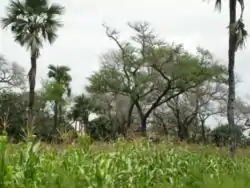
Agroforestry shares principles with intercropping but can also involve much more complex multi-strata agroforests containing hundreds of species. Agroforestry can also utilise nitrogen-fixing plants such as legumes to restore soil nitrogen fertility. The nitrogen-fixing plants can be planted either sequentially or simultaneously.
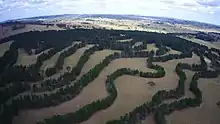
As a science
According to Wojtkowski, the theoretical base for agroforestry lies in ecology,[5] or agroecology. Agroecology encompasses diverse applications such as: improved nutrient and carbon cycling; water retention of soils; biodiverse habitats; protection from pest, disease and weed outbreaks; protection of soils from water and wind erosion, etc.[6] From this perspective, agroforestry is one of the three principal agricultural land-use sciences. The other two are agriculture and forestry.[7]
Benefits
Agroforestry systems can be advantageous over conventional agricultural and forest production methods. They can offer increased productivity; social, economic and environmental benefits, as well as greater diversity in the ecological goods and services provided.[8] Consequently, it has been proposed by Roger Leakey as a means to 'reboot' tropical agriculture.
Biodiversity
Biodiversity in agroforestry systems is typically higher than in conventional agricultural systems. Two or more interacting plant species in a given area create a more complex habitat that can support a wider variety of fauna.
Agroforestry is important for biodiversity for different reasons. It provides a more diverse habitat than a conventional agricultural system in which the tree component creates ecological niches for a wide range of organisms both above and below ground. The life cycles and food chains associated with this diversification initiates an agroecological succession that creates functional agroecosystems that confer sustainability. Tropical bat and bird diversity for instance can be comparable to the diversity in natural forests.[9] Although agroforestry systems do not provide as many floristic species as forests and do not show the same canopy height, they do provide food and nesting possibilities. A further contribution to biodiversity is that the germplasm of sensitive species can be preserved.[10] As agroforests have no natural clear areas, habitats are more uniform. Furthermore, agroforests can serve as corridors between habitats. Agroforestry can help to conserve biodiversity having a positive influence on other ecosystem services.[10]
Soil and plant growth
Depleted soil can be protected from soil erosion by groundcover plants such as naturally growing grasses in agroforestry systems. These help to stabilise the soil as they increase cover compared to short-cycle cropping systems.[11] Soil cover is a crucial factor in preventing erosion.[12] Cleaner water through reduced nutrient and soil surface runoff can be a further advantage of agroforestry. Trees can help reduce water runoff by decreasing water flow and evaporation and thereby allowing for increased soil infiltration.[13] Compared to row-cropped fields nutrient uptake can be higher and reduce nutrient loss into streams.[14][15]
Further advantages concerning plant growth:
- Bioremediation
- Drought resistance
- Increased crop stability
Contribution to sustainable agricultural systems
Agroforestry systems can provide a number of ecosystem services which can contribute to sustainable agriculture in the following ways;
- Reduced poverty through increased production of wood and other products
- Increased food security by restored soil fertility for food crops
- Land restoration through reducing soil erosion and regulating water availability [13]
- Multifunctional site use, e.g., crop production and animal grazing
- Reduced global warming and hunger risk by increasing the number of drought-resistant trees and the subsequent production of fruits, nuts and edible oils
- Reduced deforestation and pressure on woodlands by providing farm-grown fuelwood
- Reduced need for toxic chemicals (insecticides , herbicides , etc.)
- Improved human nutrition through more diverse farm outputs
- Growing space for medicinal plants e.g., in situations where people have limited access to mainstream medicines
According to FAO's The State of the World’s Forests 2020, adopting agroforestry and sustainable production practices, restoring the productivity of degraded agricultural lands, embracing healthier diets and reducing food loss and waste are all actions that urgently need to be scaled up. Agribusinesses must meet their commitments to deforestation-free commodity chains and companies that have not made zero-deforestation commitments should do so.[16]
Other environmental goals
Carbon sequestration is an important ecosystem service.[10][17] Agroforestry practices can increase carbon stocks in soil and woody biomass.[18] Trees in agroforestry systems, like in new forests, can recapture some of the carbon that was lost by cutting existing forests. They also provide additional food and products. The rotation age and the use of the resulting products are important factors controlling the amount of carbon sequestered. Agroforests can reduce pressure on primary forests by providing forest products.[19]
Agroforestry practices may realize a number of environmental goals, such as:
- Odour, dust and noise reduction
- Green space and visual aesthetics
- Enhancement or maintenance of wildlife habitat
Adaptation to climate change
Agroforestry can significantly contribute to climate change mitigation along with adaptation benefits.[20] A case study in Kenya found that the adoption of agroforestry drove carbon storage and increased livelihoods simultaneously among small-scale farmers. In this case, maintaining the diversity of tree species, especially land use and farm size are important factors.[21]
Especially in recent years, poor smallholder farmers turned to agroforestry as a means to adapt to climate change. A study from the CGIAR research program on Climate Change, Agriculture and Food Security (CCAFS) found from a survey of over 700 households in East Africa that at least 50% of those households had begun planting trees in a change from earlier practices. The trees were planted with fruit, tea, coffee, oil, fodder and medicinal products in addition to their usual harvest. Agroforestry was one of the most widespread adaptation strategies, along with the use of improved crop varieties and intercropping.[22]
Applications
Tropical Agroforestry
Research with Faidherbia albida in Zambia showed maximum maize yields of 4.0 tonnes per hectare using fertilizer and inter-cropped with these trees at densities of 25 to 100 trees per hectare,[23] compared to average maize yields in Zimbabwe of 1.1 tonnes per hectare.[24]
Hillside systems
A well-studied example of an agroforestry hillside system is the Quesungual Slash and Mulch Agroforestry System (QSMAS) in Lempira Department, Honduras. This region was historically used for slash and burn subsistence agriculture. Due to heavy seasonal floods, the exposed soil was washed away, leaving infertile barren soil exposed to the dry season.[25] Farmed hillside sites had to be abandoned after a few years and new forest was burned. The Food and Agriculture Organization of the United Nations (FAO) helped introduce a system incorporating local knowledge consisting of the following steps:[26][27]
- Thin and prune Hillside secondary forest, leaving individual beneficial trees, especially nitrogen-fixing trees. They help reduce soil erosion, maintain soil moisture, provide shade and provide an input of nitrogen-rich organic matter in the form of litter.
- Plant maize in rows. This is a traditional local crop.
- Harvest from the dried plant and plant beans. The maize stalks provide an ideal structure for the climbing bean plants. Bean is a nitrogen-fixing plant and therefore helps introduce more nitrogen.
- Pumpkin can be planted during this time. Its large leaves and horizontal growth provide additional shade and moisture retention. It does not compete with the beans for sunlight since the latter grow vertically on the stalks.
- Every few seasons, rotate the crop by grazing cattle, allowing grass to grow and adding soil organic matter and nutrients (manure). The cattle prevent total reforestation by grazing around the trees.
- Repeat.
Shade crops
With shade applications, crops are purposely raised under tree canopies within the shady environment. The understory crops are shade tolerant or the overstory trees have fairly open canopies. A conspicuous example is shade-grown coffee. This practice reduces weeding costs and improves coffee quality and taste.[28][29]
Crop-over-tree systems
Crop-over-tree systems employ woody perennials in the role of a cover crop. For this, small shrubs or trees pruned to near ground level are utilized. The purpose is to increase in-soil nutrients and/or to reduce soil erosion.
Intercropping and alley cropping
With alley cropping, crop strips alternate with rows of closely spaced tree or hedge species. Normally, the trees are pruned before planting the crop. The cut leafy material is spread over the crop area to provide nutrients. In addition to nutrients, the hedges serve as windbreaks and reduce erosion.
In tropical areas of North and South America, various species of Inga such as I. edulis and I. oerstediana have been used for alley cropping.[30]
Intercropping is advantageous in Africa, particularly in relation to improving maize yields in the sub-Saharan region. Use relies upon the nitrogen-fixing tree species Sesbania sesban, Tephrosia vogelii, Gliricidia sepium and Faidherbia albida. In one example, a ten-year experiment in Malawi showed that, by using the fertilizer tree Gliricidia (Gliricidia sepium) on land on which no mineral fertilizer was applied, maize yields averaged 3.3 tonnes per hectare as compared to one tonne per hectare in plots without fertilizer trees or mineral fertilizers.[31]
Taungya
Taungya is a system originating in Burma. In the initial stages of an orchard or tree plantation, trees are small and widely spaced. The free space between the newly planted trees accommodates a seasonal crop.[32] Instead of costly weeding, the underutilized area provides an additional output and income. More complex taungyas use between-tree space for multiple crops. The crops become more shade tolerant as the tree canopies grow and the amount of sunlight reaching the ground declines. Thinning can maintain sunlight levels.
Itteri Agroforestry[33]
Itteri agroforestry systems is a traditionally evolved in Tamil Nadu since from time immemorial. It involves the deliberate management of multipurpose trees and shrubs grown in intimate association with herbaceous species. It often occurs along the village/ farm roads, small gullies, and also along the boundaries of the agricultural field.
Temperate Agroforestry
Although originally a concept used in tropical agronomy, the USDA distinguishes five applications of agroforestry for temperate climates.[1]
Alley cropping and Strip cropping
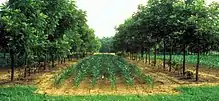
Alley cropping (see above) can also be used in temperate climates. Strip cropping is similar to alley cropping in that trees alternate with crops. The difference is that, with alley cropping, the trees are in single row. With strip cropping, the trees or shrubs are planted in wide strip. The purpose can be, as with alley cropping, to provide nutrients, in leaf form, to the crop. With strip cropping, the trees can have a purely productive role, providing fruits, nuts, etc. while, at the same time, protecting nearby crops from soil erosion and harmful winds.
Fauna-based systems
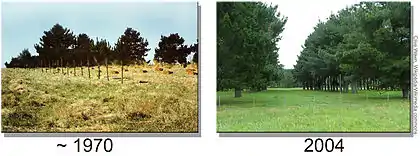
Trees can benefit fauna. The most common examples are silvopasture where cattle, goats, or sheep browse on grasses grown under trees.[34] In hot climates, the animals are less stressed and put on weight faster when grazing in a cooler, shaded environment. The leaves of trees or shrubs can also serve as fodder.
Similar systems support other fauna. Deer and hogs gain when living and feeding in a forest ecosystem, especially when the tree forage nourishes them. In aquaforestry, trees shade fish ponds. In many cases, the fish eat the leaves or fruit from the trees.
The dehesa or montado system of silviculture are an example of pigs and bulls being held extensively in Spain and Portugal.[35]
Boundary systems
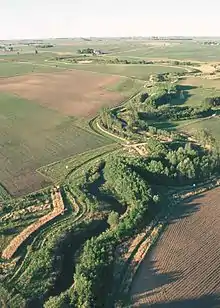
- A living fence can be a thick hedge or fence wire strung on living trees. In addition to restricting the movement of people and animals, living fences offer habitat to insect-eating birds and, in the case of a boundary hedge, slow soil erosion.
- Riparian buffers are strips of permanent vegetation located along or near active watercourses or in ditches where water runoff concentrates. The purpose is to keep nutrients and soil from contaminating the water.
- Windbreaks reduce wind velocity over and around crops. This increases yields through reduced drying of the crop and/or by preventing the crop from toppling in strong wind gusts.
Agroforestry in Switzerland
Since the 1950s, 4/5 of Swiss hochstammobstgärten (traditional orchards with tall trees) have disappeared. An agroforestry scheme was tested here with hochstamm trees together with annual crops. Trees tested were walnut tree (Juglans regia) and cherry tree (Prunus avium). Forty to seventy trees per hectare were recommended, yields were somewhat decreasing with increasing tree height and foliage.[36] However, the total yield per area is shown to be up to 30 percent higher than for monocultural systems.[37]
Another set of tests involve growing Populus tremula for biofuel at 52 trees a hectare and with grazing pasture alternated every two to three years with maize or sorghum, wheat, strawberries and fallowing between rows of modern short-pruned & grafted apple cultivars ('Boskoop' & 'Spartan') and growing modern sour cherry cultivars ('Morina', 'Coraline' und 'Achat') and apples, with bushes in the rows with tree (dogrose, Cornus mas, Hippophae rhamnoides) intercropped with various vegetables.[38]
Historical use
Similar methods were historically utilized by Native Americans. California Indians periodically burned oak and other habitats to maintain a 'pyrodiversity collecting model'. This method allowed for greater tree health and improved habitat in general.[39]
Challenges
Although agroforestry systems can be advantageous,[8][40] they are not widespread in the US as of 2013.[40][41]
As suggested by a survey of extension programs in the United States, obstacles (ordered most critical to least critical) to agroforestry adoption include:[41]
- Lack of developed markets
- Unfamiliarity with technologies
- Lack of awareness
- Competition between trees, crops and animals
- Lack of financial assistance
- Lack of apparent profit potential
- Lack of demonstration sites
- Expense of additional management
- Lack of training or expertise
- Lack of knowledge about where to market products
- Lack of technical assistance
- Adoption/start up costs, including costs of time
- Unfamiliarity with alternative marketing approaches (e.g. web)
- Unavailability of information about agroforestry
- Apparent inconvenience
- Lack of infrastructure (e.g. buildings, equipment)
- Lack of equipment
- Insufficient land
- Lack of seed/seedling sources
- Lack of scientific research
Some solutions to these obstacles have been suggested.[41]
See also
- Afforestation
- Analog forestry
- Buffer strip
- Carbon farming
- Deforestation
- Deforestation and climate change
- Farmer-managed natural regeneration
- Fertilizer tree
- Forest farming
- Forest gardening
- Hedge
- Mycoforestry
- Orchard
- Pastoral farming
- Permaculture
- Streuobstwiese
- Sustainable agriculture
- Silviculture
- Silvopasture
- World Forestry Congress
Sources
![]() This article incorporates text from a free content work. Licensed under CC BY-SA 3.0 IGO License statement/permission on Wikimedia Commons. Text taken from The State of the World’s Forests 2020. Forests, biodiversity and people – In brief, FAO & UNEP, FAO & UNEP.
This article incorporates text from a free content work. Licensed under CC BY-SA 3.0 IGO License statement/permission on Wikimedia Commons. Text taken from The State of the World’s Forests 2020. Forests, biodiversity and people – In brief, FAO & UNEP, FAO & UNEP.
References
- "National Agroforestry Center". USDA National Agroforestry Center (NAC).
- Kuyah, Shem; Öborn, Ingrid; Jonsson, Mattias; Dahlin, A Sigrun; Barrios, Edmundo; Muthuri, Catherine; Malmer, Anders; Nyaga, John; Magaju, Christine; Namirembe, Sara; Nyberg, Ylva; Sinclair, Fergus L (2016). "Trees in agricultural landscapes enhance provision of ecosystem services in Sub-Saharan Africa". International Journal of Biodiversity Science, Ecosystems Services and Management: 1–19. doi:10.1080/21513732.2016.1214178.
- Iqbal, Nausheen. "A Food Forest Grows in Atlanta". USDA.gov blog. Retrieved 17 June 2018.
- Schoeneberger, Michele M. (2017). "Agroforestry: Enhancing resiliency in U.S. agricultural landscapes under changing conditions". Gen. Tech. Report WO-96. doi:10.2737/WO-GTR-96. Retrieved 17 June 2018.
- Wojtkowski, Paul A. (1 December 1998). The theory and practice of agroforestry design: a comprehensive study of the theories, concepts and conventions that underlie the successful use of agroforestry. Science Publishers. ISBN 978-1-57808-034-2.
- Wojtkowski, P. (2019) Agroecology: Simplified and Explained, Springer, 420p.
- Wojtkowski, Paul Anthony (2002). Agroecological Perspectives in Agronomy, Forestry, and Agroforestry. Science Publishers. ISBN 978-1-57808-217-9.
- "Benefits of agroforestry". Agroforestry Research Trust [in England]. Archived from the original on 20 April 2015.
- Harvey, Celia A.; Villalobos, Jorge A. González (1 July 2007). "Agroforestry systems conserve species-rich but modified assemblages of tropical birds and bats". Biodiversity and Conservation. 16 (8): 2257–2292. doi:10.1007/s10531-007-9194-2. ISSN 0960-3115.
- Jose, S. (2009). Agroforestry for ecosystem services and environmental benefits: an overview. Agroforestry Systems, 76(1), 1–10. doi:10.1007/s10457-009-9229-7
- Béliveau, Annie; Lucotte, Marc; Davidson, Robert; Paquet, Serge; Mertens, Frédéric; Passos, Carlos J.; Romana, Christine A. (December 2017). "Reduction of soil erosion and mercury losses in agroforestry systems compared to forests and cultivated fields in the Brazilian Amazon". Journal of Environmental Management. 203 (Pt 1): 522–532. doi:10.1016/j.jenvman.2017.07.037. ISSN 0301-4797. PMID 28841519.
- Young, Anthony (1994). Agroforestry for Soil Conservation. CAB International.
- FAO. 2017. Agroforestry for landscape restoration: Exploring the potential of agroforestry to enhance the sustainability and resilienceof degradedlandscapes. Rome. https://doi.org/10.4060/i7374e
- Udawatta, Ranjith P.; Krstansky, J. John; Henderson, Gray S.; Garrett, Harold E. (July 2002). "Agroforestry practices, runoff, and nutrient loss: a paired watershed comparison". Journal of Environmental Quality. 31 (4): 1214–1225. doi:10.2134/jeq2002.1214. ISSN 0047-2425. PMID 12175039.
- Jose, Shibu (1 May 2009). "Agroforestry for ecosystem services and environmental benefits: an overview". Agroforestry Systems. 76 (1): 1–10. doi:10.1007/s10457-009-9229-7. ISSN 0167-4366.
- The State of the World’s Forests 2020. Forests, biodiversity and people – In brief. Rome: FAO & UNEP. 2020. ISBN 978-92-5-132707-4.
- "Multistrata Agroforestry". Project Drawdown. 7 February 2020. Retrieved 4 December 2020.
- Read "Negative Emissions Technologies and Reliable Sequestration: A Research Agenda" at NAP.edu.
- Montagnini, F.; Nair, P. K. R. (1 July 2004). "Carbon sequestration: An underexploited environmental benefit of agroforestry systems". Agroforestry Systems. 61–62 (1–3): 281. doi:10.1023/B:AGFO.0000029005.92691.79. ISSN 0167-4366.
- Zomer, Robert J.; Neufeldt, Henry; Xu, Jianchu; Ahrends, Antje; Bossio, Deborah; Trabucco, Antonio; van Noordwijk, Meine; Wang, Mingcheng (20 July 2016). "Global Tree Cover and Biomass Carbon on Agricultural Land: The contribution of agroforestry to global and national carbon budgets". Scientific Reports. 6 (1): 29987. Bibcode:2016NatSR...629987Z. doi:10.1038/srep29987. ISSN 2045-2322.
- Reppin, Saskia; Kuyah, Shem; de Neergaard, Andreas; Oelofse, Myles; Rosenstock, Todd S. (16 March 2019). "Contribution of agroforestry to climate change mitigation and livelihoods in Western Kenya". Agroforestry Systems. doi:10.1007/s10457-019-00383-7. ISSN 1572-9680.
- Kristjanson, P; Neufeldt H; Gassner A; Mango J; Kyazze FB; Desta S; Sayula G; Thiede B; Forch W; Thornton PK; Coe R (2012). "Are food insecure smallholder households making changes in their farming practices? Evidence form East Africa". Food Security. 4 (3): 381–397. doi:10.1007/s12571-012-0194-z.
- Langford, Kate (8 July 2009). "Turning the tide on farm productivity in Africa: an agroforestry solution". World Agroforestry Centre. Archived from the original on 20 June 2010. Retrieved 2 April 2014.
- Bayala, Jules; Larwanou, Mahamane; Kalinganire, Antoine; Mowo, Jeremias G.; Weldesemayat, Sileshi G.; Ajayi, Oluyede C.; Akinnifesi, Festus K.; Garrity, Dennis Philip (1 September 2010). "Evergreen Agriculture: a robust approach to sustainable food security in Africa" (PDF). Food Security. 2 (3): 197–214. doi:10.1007/s12571-010-0070-7. ISSN 1876-4525.
- Ayarza, M. A.; Welchez, L. A. (2004). "Drivers effecting the development and sustainability of the Quesungual Slash and Mulch Agroforestry System (QSMAS) on hillsides of Honduras" (PDF). In Noble, A. (ed.). fComprehensive Assessment Bright Spots Project Final Report. Retrieved 14 January 2018.
- Conservation Agriculture: Case Studies in Latin America and Africa. FAO. 2001.
- Pauli, N.; Barrios, E.; Conacher, A. J.; Oberthür, T. (2011). "Soil macrofauna in agricultural landscapes dominated by the Quesungual Slash-and-Mulch Agroforestry System, western Honduras" (PDF). Applied Soil Ecology. 47 (2): 119–132. doi:10.1016/j.apsoil.2010.11.005. Archived from the original (PDF) on 24 March 2016. Retrieved 6 December 2017 – via Elsevier.
- "CATIE | Arboles en cafetales". www.catie.ac.cr. Retrieved 23 April 2018.
- Muschler, R. G. (1 August 2001). "Shade improves coffee quality in a sub-optimal coffee-zone of Costa Rica". Agroforestry Systems. 52 (3): 253. doi:10.1023/A:1011863426305. ISSN 0167-4366.
- "The Rainforest Saver". The Ecologist. Retrieved 23 April 2018.
- Akinnifesi, F. K.; Makumba, W.; Kwesiga, F. R. (2006). "Sustainable Maize Production Using Gliricidia/Maize Intercropping in Southern Malawi" (PDF). Experimental Agriculture. 42 (4): 10 (1–17). doi:10.1017/S0014479706003814. Archived from the original (PDF) on 14 July 2014.
- Abugre, S.; Asare, A.I.; Anaba, J.A. (2010). "Gender equity under the Modified Taungya System (MTS). A case of the Bechem Forest District of Ghana" (PDF). International Journal of Social Forestry. 3 (2): 134–150 (137). Archived from the original (PDF) on 19 August 2015.
- Van, Sangyan (February 2019). "Itteri Biofence- Solution for Peafowl nusiance" (PDF). vansangyan. 6: 33–34.
- "Silvopasture". Agroforestry Research Trust [in England]. Archived from the original on 20 April 2015. Retrieved 19 August 2015.
- Fra. Paleo, Urbano. (2010). "The dehesa/montado landscape". pp. 149–151 in Sustainable Use of Biological Diversity in Socio-ecological Production Landscapes, eds. Bélair, C., Ichikawa, K., Wong, B.Y.L. and Mulongoy, K.J. Montreal: Secretariat of the Convention on Biological Diversity. Technical Series no. 52.
- AGROFORST. "AGROFORST > Publikationen > Publikationen und Dokumente Schweiz" (PDF). agroforst.ch (in German). Retrieved 23 April 2018.
- AGROFORST. "Agroforstwirtschaft in der Schweiz" (PDF). agrarforschungschweiz.ch (in German). Retrieved 22 August 2020.
- AGROFORST. "AGROFORST > Publikationen > Publikationen und Dokumente Schweiz" (PDF). agroforst.ch (in German). Retrieved 23 April 2018.
- Lightfoot, Kent (2009). California Indians and Their Environment: An Introduction. Berkeley: University of California Press.
- "Agroforestry Frequently Asked Questions". United States Department of Agriculture. 28 October 2013. Archived from the original on 1 March 2014. Retrieved 19 February 2014.
- Jacobson, Michael; Shiba Kar (August 2013). "Extent of Agroforestry Extension Programs in the United States". Journal of Extension. 51 (4). Archived from the original on 8 September 2013. Retrieved 19 February 2014.
Further reading and listening
- Patish, Daizy Rani, ed. (2008). Ecological basis of agroforestry. CRC Press. ISBN 978-1-4200-4327-3.
- The Springer Journal, "Agroforestry Systems" (ISSN 1572-9680); Editor-In-Chief: Prof. Shibu Jose, H.E. Garrett Endowed Professor and Director, The Center for Agroforestry, University of Missouri
- Robbins, Jim (21 November 2011). "A Quiet Push to Grow Crops Under Cover of Trees". The New York Times. Retrieved 22 November 2011.
- Interview with Eric Toensmeier on carbon farming (archive here, audio here), from Living on Earth show broadcast 25 November 2016.
External links
| Wikimedia Commons has media related to Agroforestry. |
- National Agroforesty Center (USDA)
- World Agroforestry Centre
- The CGIAR Research Program on Forests, Trees and Agroforestry (FTA)
- The Center for Agroforestry at the University of Missouri
- Australian Agroforestry Foundation
- Australian agroforestry
- The Green Belt Movement
- Plants For A Future
- Ya'axché Conservation Trust
- Trees for the Future
- Free Distance Agroforestry Training Manual (from Trees for the Future)
- Vi-Agroforestry
- Agroforst in Deutschland
- Agroforestry in France and Europe
- Media
- "Agroforestry makes sense for marginalised people in the Philippines uplands" (Erhardt/Bünner), article in the magazine D+C Development and Cooperation
- The short film Agroforestry Practices – Alley Cropping (2004) is available for free download at the Internet Archive.
- The short film Agroforestry Practices – Forest Farming (2004) is available for free download at the Internet Archive.
- The short film Agroforestry Practices – Riparian Forest Buffers (2004) is available for free download at the Internet Archive.
- The short film Agroforestry Practices – Silvopasture (2004) is available for free download at the Internet Archive.
- The short film Agroforestry Practices – Windbreaks (2004) is available for free download at the Internet Archive.
- Agroforestry, stakes and perspectives. Agroof Production, Liagre F. and Girardin N.